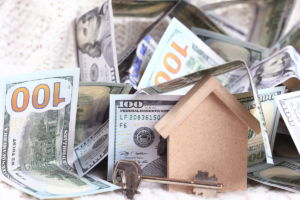Understanding Cash-Out Refinance Spending
Ever wondered how homeowners suddenly embark on huge home improvement projects or pay off significant debts? It might be the magic of cash-out refinance spending. So, what exactly is a cash-out refinance? It’s a mortgage refinancing option where the new mortgage is for a larger amount than the current loan. The difference? The homeowner gets it in cash. Picture swapping out your old mortgage for a new one, but with a bit more pocket change. In recent years, with the surging property values and a growing need for liquidity, many homeowners have turned to cash-out refinancing as their go-to financial solution. But like any financial move, it comes with its own set of pros and cons.

The Mechanics of Cash-Out Refinancing
Diving into the world of mortgages and refinancing can seem like you’re navigating a labyrinth. However, understanding the nuts and bolts of cash-out refinancing can make this maze simpler. So, let’s break it down.
How Does it Work?
At its core, cash-out refinancing is a two-pronged approach: It’s about restructuring your current mortgage while also extracting equity from your home in cold hard cash. Imagine it’s like selling a part of your home back to the bank, but without moving out.
The Process Step by Step:
- Assess Your Home’s Value: Before anything, get a professional appraisal to determine the current market value of your home. This becomes your benchmark. Let’s take a hypothetical scenario – your home is now valued at $400,000.
- Determine Your Existing Mortgage: Now, see how much you still owe the bank. In this case, you owe $250,000.
- Calculate the Maximum New Loan: Depending on your creditworthiness and market conditions, lenders usually allow you to borrow up to 80% of your home’s value. For our example, that’s 80% of $400,000 which equals $320,000. Check out our handy mortgage calculator.
- Receive the Difference in Cash: Refinancing to this new amount means your old mortgage ($250,000) is paid off, and you’re left with the difference as cash. Voila, you have $70,000 in hand!
Benefits Over Other Financial Solutions:
Why would one consider this over, say, a personal loan or a credit card?
- Lower Interest Rates: Mortgage interest rates tend to be significantly lower than credit cards and most personal loans. By tapping into cash-out refinance, you can potentially access large amounts of money without the intimidating interest rates other borrowing methods might sling at you.
- Consolidation: Many homeowners use this strategy to consolidate and pay down higher-interest debts. This not only simplifies their financial landscape but also saves money in the long run.
- Tax Deductions: Unlike credit card interest, mortgage interest can often be deducted on your taxes, which can lead to considerable savings.
When to Consider It?
Understanding when to pull the trigger is just as vital as understanding how.
Ideal Situations for Cash-Out Refinance:
- Surging Home Value: If your local real estate market is booming and your home’s value has skyrocketed since purchase, this could be an opportune moment.
- Ample Home Equity: Equity is the difference between your home’s value and what you owe. The more equity you have, the more you can borrow.
- Large Expenses on the Horizon: Whether it’s giving your home a facelift, paying for a child’s education, or consolidating debt, if you have a big expense coming up, this might be your answer.
Risks Involved:
Like all financial strategies, there’s no free lunch.
- Higher Monthly Payments: Refinancing could lead to a higher monthly mortgage payment, depending on the terms. You must ensure you have the consistent cash flow to handle this.
- Closing Costs: Refinancing isn’t free. There are closing costs involved, which can sometimes run into thousands of dollars. It’s essential to ensure that the benefits outweigh these upfront costs.
- Your Home on the Line: The most crucial risk to understand – if you can’t handle the new mortgage payment, you’re putting your home at risk. Always be realistic about what you can afford.
In the realm of financial strategies, cash-out refinancing is a potent tool. However, as with all tools, wield it wisely and with full knowledge of its pros and cons.
Wise Spending: Making the Most of Your Cash-Out Refinance
That fresh influx of money in your account from a cash-out refinance feels liberating. Like a child in a candy store, the possibilities seem endless. However, remember this isn’t a windfall or lottery win; it’s strategic borrowing. So, how do you make the most of it without feeling the hangover later?
Best Practices in Spending the Cash
Home Improvements: Your home is probably your most significant asset. Investing back into it can be a smart move. Consider areas that offer the best return on investment:
-
- Kitchen renovations often recoup 70-80% of the costs when selling.
- Adding energy-efficient features can reduce your monthly utility bills, while also making your home appealing to future buyers.
- Bathroom remodels or adding a new one can significantly bump up your home’s value.
Debt Consolidation: Debt can feel like a boulder on your back. By using your funds to squash high-interest debts, especially credit card balances, you’re effectively trading expensive debt for cheaper debt. The peace of mind? Priceless.
Education or Business Investment: Your future earning potential or that of your children can significantly benefit from further education or skill development. Similarly, if you’ve been mulling over starting a small business or scaling an existing one, this could be your seed money. Just ensure you’ve done thorough research and perhaps even consulted with an expert.
Pitfalls to Avoid
Overextending Yourself: Imagine this: A lavish vacation or that high-end car you’ve been eyeing. Tempting, right? But always prioritize needs over wants. Create a budget and stick to it.
Ignoring the Long-Term Costs: It’s not just about the interest rate. It’s about the term, the total amount repayable, and the implications on your monthly cash flow. You might be paying less per month now, but for many more years, meaning the overall repayment could be higher.
Comparing to Other Financial Solutions
Cash-out refinancing might feel like the answer to all your prayers, but it’s only one tool in a vast financial toolbox.
Home Equity Line of Credit (HELOCs): Think of this as a credit card backed by your home’s equity. It offers flexibility but usually has a variable interest rate, which can be tricky in a fluctuating market.
Personal Loans: These are unsecured, meaning they don’t require collateral like your home. They’re fast and can have fixed interest rates, but often at a higher rate due to the lack of collateral.
Traditional Refinancing: If you’re simply looking to take advantage of lower market interest rates and don’t need the extra cash, traditional refinancing might be the route for you.
When deciding, look beyond just the immediate need. Think long-term, project into the future, and consult with professionals. The goal? To ensure your financial health remains robust and resilient. Contact our team to explore your options.
The LeaderOne Lowdown on Cash-Out Refinance Spending
Cash-out refinance spending offers a unique opportunity for homeowners. However, it’s essential to approach it with a clear understanding and strategy. Your home’s equity can be a powerful tool, but like all tools, it should be used wisely and responsibly.
FAQs
- What’s the primary difference between cash-out refinance and a home equity loan? A cash-out refinance means a reboot of your existing mortgage under new terms and a higher loan amount. In contrast, a home equity loan leaves your original mortgage untouched and functions as a second loan.
- Is the cash from refinance taxable? No, it’s usually like borrowing money from a lender. However, the world of taxation has its complexities. Always ensure to check with a tax expert to get the specifics for your situation.
- Can I use cash-out refinance for any purpose? The short answer? Yes. The wise answer? Spend it on investments or endeavors that enhance your financial stability or personal growth.
- Does cash-out refinance affect credit score? Just like any loan application, it can put a small dent in your score temporarily. Yet, using the cash to pay off high-interest debts can bolster your score in the long run.
- How much equity do I need for a cash-out refinance? While the specifics can vary, a general rule of thumb is maintaining at least 20% equity in your home post-refinance. It’s always best to discuss with your lender for precise figures.




